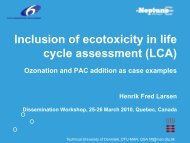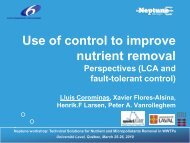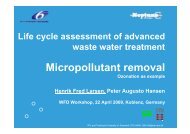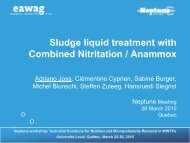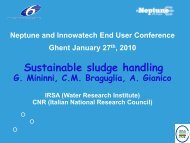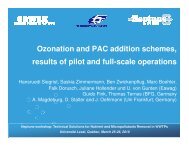D2.1 - EU Project Neptune
D2.1 - EU Project Neptune
D2.1 - EU Project Neptune
Create successful ePaper yourself
Turn your PDF publications into a flip-book with our unique Google optimized e-Paper software.
NEPTUNE · Contract-No. 036845 Deliverable 2.1<br />
species. Aeration can also be provided directly in the reactor. Because of the densely packed<br />
hollow fibers, BioMnOx was in close contact with the membrane surface and retained<br />
physically in the reactor. However, in a conventional MBR, BioMnOx would be mainly<br />
present as suspended matter, which would increase mixing and therefore reactivity.<br />
The main factors influencing the oxidation of micropollutants with BioMnOx are the complex<br />
matrix of wastewater effluent, including residual organics and ions such as NH + 4 , the “aging”<br />
of the BioMnOx and the presence of other micropollutants. Matrix-effect tests showed a<br />
decreased diclofenac removal by a factor of 2 at a stable pH of 6.8 and by a factor of 5 in the<br />
absence of a pH buffer. After 1.5 months without C-source, BioMnOx showed a 1.5-fold<br />
lower activity towards diclofenac removal.<br />
The reactor was operated for a period of 45 days on wastewater effluent, retrieved from a<br />
municipal wastewater treatment plant. Different hydraulic residence times (HRT) were<br />
applied as shown in Figure 3.9.<br />
Figure 3.9 Operation of MBR with BioMnOx for the removal of micropollutants from<br />
wastewater effluent: HRT and sampling points.<br />
Influent and effluent samples, taken twice a week, were analyzed for the presence of 35<br />
compounds and 24 were detected frequently. The influent concentrations were below<br />
1 µg L -1 except for the iodinated contrast media (ICM). For example diclofenac was detected<br />
between 200 and 800 ng L -1 . Figure 3.10 shows the removal efficiencies for all the<br />
compounds detected. The acidic pharmaceuticals ibuprofen, diclofenac, naproxen and<br />
benzafibrate, the antibiotic clarithromycin and the analgesic codeine are removed by<br />
BioMnOx in a MBR. In Figure 3.11, the influence of HRT on the removal of acidic<br />
pharmaceuticals is presented. Diclofenac removal at ng L -1 levels is sensitive to the HRT<br />
applied.<br />
Diclofenac removal drops significantly when HRT is lowered from 5 to 2.5 h and it is<br />
subsequently restored when HRT is raised to 24 hours. After 3 weeks, removal of ibuprofen<br />
is hampered. It is likely that ibuprofen is biologically degraded by the manganese-oxidizing<br />
bacteria Pseudomonas putida, that is part of the BioMnOx, because ibuprofen is<br />
biodegradable (Joss et al., 2006). After 3 weeks of starvation, the biological action of<br />
BioMnOx (removal of biologically degradable matter and re-oxidation of Mn 2+ ) is decreased.<br />
Nevertheless, Mn 2+ concentrations were below detection limit (0.1 mg L -1 ).<br />
18



